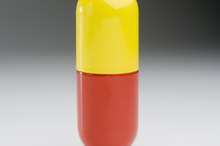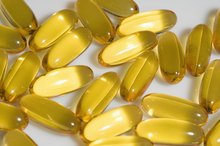Importance of Exercise With Thyroid Disease
The thyroid is a small gland located in the lower part of the neck that secrets hormones, mainly triiodothyronine, or T3; and thyroxine, or T4. When the thyroid malfunctions, hormone levels, metabolism, energy and weight can fluctuate 1. Exercise can help reduce the symptoms of many thyroid diseases, however, by stabilizing metabolism, weight and energy levels 1.
Types
Hypothyroid occurs when the thyroid does not release enough hormones, and can result in weight gain, fatigue and depression 1. Hyperthyroid is characterized by an excess of hormone secretion, which can spur weight loss, nervousness and rapid heartbeat. Thyroiditis is when the thyroid becomes inflamed from bacterial or viral infection. Goiter is the condition of having an enlarged thyroid. Thyroid nodules are solid or liquid filled cysts, lumps, bumps and tumors — which can be benign or cancerous — in the thyroid.
- Hypothyroid occurs when the thyroid does not release enough hormones, and can result in weight gain, fatigue and depression 1.
Exercise, Hypothyroidism and Hyperthyroidism
Exercises for Hyperthyroidism
Learn More
Many thyroid diseases require medication, and exercise can compliment treatment. Exercise raises your metabolism and increases lean muscle mass, helping you burn more calories. Exercise also boosts mood and energy levels. Hyperthyroidism can cause sleeplessness and low energy levels, both of which may be lessened with regular exercise 24.
- Many thyroid diseases require medication, and exercise can compliment treatment.
- Exercise raises your metabolism and increases lean muscle mass, helping you burn more calories.
Exercise and Thyroid Hormones
Aerobic exercise can increase hormone production in the thyroid, according to the study "Exercise Intensity and its Effects on Thyroid Hormones," published in Vol 5. 26 of Neuroendocrinology Letters 5. Regular aerobic exercise can boost levels of T4 and T3, helping people who have low levels of hormones in the thyroid, such as patients with hypothyroidism or autoimmune diseases affecting the thyroid. Increased hormone production can, in turn, decrease the negative side effects of many thyroid disorders.
Exercise Considerations
L-Carnitine & Hypothyroidism
Learn More
The American College of Sports Medicines recommends that adults do moderately intense cardiovascular workouts for 30 minutes a day, five days a week, for maximum health benefits. If you have a thyroid disorder, consult your doctor before beginning an exercise program, as your condition may require less or more exercise and intensity. For thyroid patients, moderately intense aerobic exercises can offer the health benefits of boosting metabolism and mood without stressing the body as much as intense cardio workouts 3.
Warning
Exercise can help alleviate the symptoms of some thyroid conditions, but it is not a substitute for medical treatment. If you have or suspect you have a thyroid disease, see your doctor for an accurate diagnosis and treatment. Medication is often prescribed to combat common conditions such as hypothyroidism and hyperthyroidism, and can alleviate symptoms 24. If you experience sharp or lasting pain or fatigue while working out, stop immediately and see your doctor. Thyroid patients should be cautious not to exercise excessively, as low energy levels and muscle weakness are common problems for those with thyroid disorders.
- Exercise can help alleviate the symptoms of some thyroid conditions, but it is not a substitute for medical treatment.
- Thyroid patients should be cautious not to exercise excessively, as low energy levels and muscle weakness are common problems for those with thyroid disorders.
Related Articles
References
- Mayo Clinic: Hyperthyroidism
- Thyroid Health: How Exercises Benefit Hypothyroidism
- MyThyroid.com: Hyperthyroidism
- American Thyroid Association. General Information/Press Room.
- Pirahanchi Y, Jialal I. Physiology, Thyroid Stimulating Hormone (TSH). In: StatPearls [Internet]. Treasure Island (FL): StatPearls Publishing; 2019 Jan-. Updated April 25, 2019.
- AACC. Hashimoto Thyroiditis. Lab Tests Online. Updated October 18, 2019.
- DeGroot LJ. Graves’ Disease and the Manifestations of Thyrotoxicosis. [Updated 2015 Jul 11]. In: Feingold KR, Anawalt B, Boyce A, et al., editors. Endotext [Internet]. South Dartmouth (MA): MDText.com, Inc.; 2015.
- Nguyen QT, Lee EJ, Huang MG, Park YI, Khullar A, Plodkowski RA. Diagnosis and treatment of patients with thyroid cancer. Am Health Drug Benefits. 2015;8(1):30-40.
- Bindra A, Braunstein GD. Thyroiditis. Am Fam Physician. 2006;73(10):1769-76.
- Medeiros-Neto G. Multinodular Goiter. In: Feingold KR, Anawalt B, Boyce A, et al., editors. Endotext [Internet]. South Dartmouth (MA): MDText.com, Inc.; 2000-. Updated September 26, 2016.
- The National Institute of Diabetes and Digestive and Kidney Diseases. Hypothyroidism (Underactive Thyroid). Published August 2016.
- The National Institute of Diabetes and Digestive and Kidney Diseases. Hyperthyroidism (Overactive Thyroid). Published August 2016.
- Brent GA. Environmental exposures and autoimmune thyroid disease. Thyroid. 2010;20(7):755-61. doi:10.1089/thy.2010.1636
- Mcaninch EA, Bianco AC. The history and future of treatment of hypothyroidism. Ann Intern Med. 2016;164(1):50-6. doi:10.7326/M15-1799
- The National Institute of Diabetes and Digestive and Kidney Diseases. Grave’s Disease. Published September 2017.
- Stagnaro-Green, A., Abalovich, M, Alexander, E. et. al. Guidelines of the American thyroid association for the diagnosis and management of thyroid disease during pregnancy and postpartum. Thyroid. 2011(21)10. doi:10.1089/thy.2011.0087
- Liu G, Liang L, Bray GA, et al. Thyroid hormones and changes in body weight and metabolic parameters in response to weight loss diets: the POUNDS LOST trial. Int J Obes (Lond). 2017;41(6):878-886. doi:10.1038/ijo.2017.28
- Bahn R, Burch H, Cooper D, et al. Hyperthyroidism and other causes of thyrotoxicosis: Management guidelines of the American Thyroid Association and American Association of Clinical Endocrinologists. Endocrine Practice. 2011;17(3). doi:10.1089/thy.2010.0417
- Braverman L, Cooper D. Werner & Ingbar's The Thyroid, 10th Edition. WLL/Wolters Kluwer; 2012.
- Garber J, Cobin R, Gharib H, et. al. Clinical practice guidelines for hypothyroidism in adults: Cosponsored by the American Association of Clinical Endocrinologists and the American Thyroid Association. Endocrine Practice. 2012;18(6). doi:10.1089/thy.2012.0205
- Haugen A, Alexander K., Bible K, et. al. 2015 American Thyroid Association Management guidelines for adult patients with thyroid nodules and differentiated thyroid cancer. Thyroid. 2016;26(1):1-133. doi:10.1089/thy.2015.0020
- Smallridge R, Ain K, Asa S, et. al. American Thyroid Association guidelines for management of patients with anaplastic thyroid cancer. Thyroid. 2012;22(11). doi:10.1089/thy.2012.0302
- Wells, S, Asa S, Dralle H, et. al. Revised American Thyroid Association guidelines for the management of medullary thyroid carcinoma. Thyroid. 2015;25(6). doi:10.1089/thy.2014.0335
Resources
Writer Bio
Marnie Kunz has been an award-winning writer covering fitness, pets, lifestyle, entertainment and health since 2003. Her articles have been published in "The Atlanta Journal-Constitution," "Alive," "The Marietta Daily Journal" and other publications. Kunz holds a Bachelor of Arts in creative writing from Knox College and is a Road Runners Club of America-certified running coach and a certified pole dance instructor.








